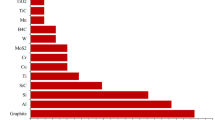Abstract
Electric discharge machining is one of the widely used nontraditional methods in manufacturing industry. In the present study, the effects of discharge energy density on the material removal rate, electrode wear rate, surface average roughness of the workpiece and the tool electrode were investigated. AISI 1040 steel as workpiece material and electrolytic copper as tool electrode were selected. Experiments were designed and conducted using one-factor-at-a-time approach. During the experiments, current and voltage were kept constant, whereas pulse on time and pulse off time were varied at two levels. In order to investigate and analyze the effects of discharge energy density on the responses, different diameters of the tool electrode were used. It has been observed that the discharge energy density could be considered as a significant factor for appropriate selection of process parameters for better machining characteristics.
Similar content being viewed by others
References
Ho KH, Newman ST (2003) State of the art electrical discharge machining (EDM). Int J Mach Tools Manuf 43:1287–1300
Hocheng H, Guu YH, Tsai HY (2013) Advanced analysis of nontraditional machining. Springer Science-Business Media, New York, pp 65–106, ISBN 978-1-4614-4053-6
Jahan MP, Davim JP (2013) Nontraditional machining processes. Springer, London, pp 111–152, ISBN 978-1-4471-5178-4
Guu YH, Chou CY, Chiou ST (2005) Study of the effect of machining parameters on the machining characteristics in electrical discharge machining of Fe-Mn-Al alloy. Mater Manuf Process 20:905–916
Rebelo JC, Dias AM, Kremer D, Lebrun JL (1998) Influence of EDM pulse energy on the surface integrity of martensitic steels. J Mater Process Technol 84:90–96
Liu CC (2003) Microstructure and tool electrode erosion in EDMed of TiN/Si3N4 composites. Mater Sci Eng A A363:221–227
Zarepour H, Tehrani AF, Karimi D, Amini S (2007) Statistical analysis on electrode wear in EDM of tool steel DIN 1.2714 used in forging dies. J Mater Process Technol 187–188:711–714
Lee HT, Hsu FC, Tai TY (2004) Study of surface integrity using the small area EDM process with a copper–tungsten electrode. Mater Sci Eng A A364:346–356
Amorim FL, Weingaertner WL (2005) The influence of generator actuation mode and process parameters on the performance of finish EDM of a tool steel. J Mater Process Technol 166:411–416
Haron CHC, Deros BM, Ginting A, Fauziah M (2001) Investigation on the influence of machining parameters when machining tool steel using EDM. J Mater Process Technol 116:84–87
Lin Y-C, Chen Y-F, Lin C-T, Tzeng H-J (2008) Electrical discharge machining (EDM) characteristics associated with electrical discharge energy on machining of cemented tungsten carbide. Mater Manuf Process 23:391–399
Lin Y-C, Hwang L-R, Cheng C-H, Su P-L (2008) Effects of electrical discharge energy on machining performance and bending strength of cemented tungsten carbides. J Mater Process Technol 206:491–499
Singh S, Maheshwari S, Pandey PC (2004) Some investigations into the electric discharge machining of hardened tool steel using different electrode materials. J Mater Process Technol 149:272–277
Gostimirovic M, Kovac P, Sekulic M, Skoric B (2012) Influence of discharge energy on machining characteristics in EDM. J Mech Sci Technol 26:173–179
Sánchez HT, Estrems M, Faura F (2001) Development of an inversion model for establishing EDM input parameters to satisfy material removal rate, electrode wear ratio and surface roughness. Int J Adv Manuf Technol 57:189–201
Che Haron CH, Ghani JA, Burhanuddin Y, Seong YK, Swee CY (2008) Copper and graphite electrodes performance in electrical-discharge machining of XW42 tool steel. J Mater Process Technol 201:570–573
Shankar P, Jain VK, Sundararajanet T (1997) Analysis of spark profiles during EDM process. Mach Sci Technol 1(2):195–217
Madhu P, Jain VK, Sundararajan T, Rajurkar KP (1991) Finite element analysis of EDM process. Mater Sci Forum 1(3/4):161–174
Son S, Lim H, Kumar AS, Rahman M (2007) Influences of pulsed power condition on the machining properties in micro EDM. J Mater Process Technol 190:73–76
Author information
Authors and Affiliations
Corresponding author
Rights and permissions
About this article
Cite this article
Kiyak, M., Aldemir, B.E. & Altan, E. Effects of discharge energy density on wear rate and surface roughness in EDM. Int J Adv Manuf Technol 79, 513–518 (2015). https://doi.org/10.1007/s00170-015-6840-9
Received:
Accepted:
Published:
Issue Date:
DOI: https://doi.org/10.1007/s00170-015-6840-9




